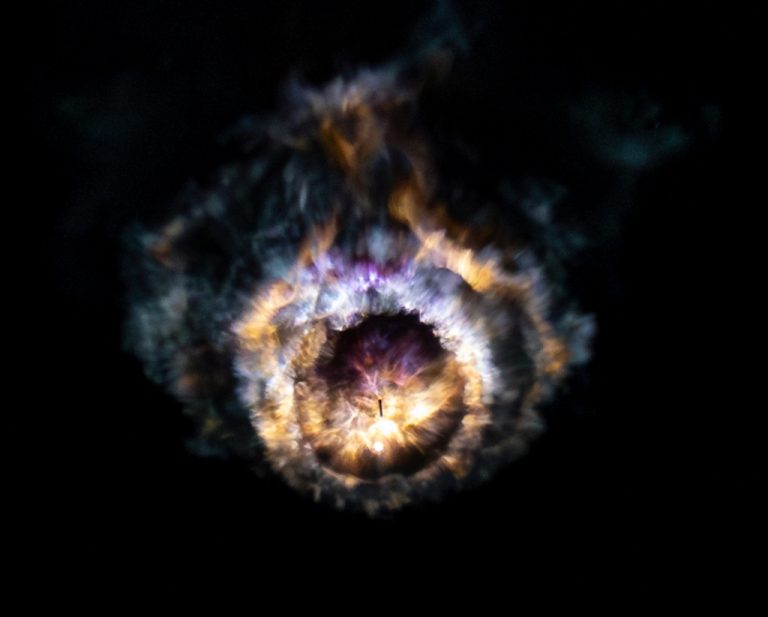阿波罗17号的月艇
See Explanation. Clicking on the picture will download the highest resolution version available.
请参阅说明。单击图片将下载可用的最高分辨率版本。

See Explanation. Clicking on the picture will download the highest resolution version available.
请参阅说明。单击图片将下载可用的最高分辨率版本。

请参阅说明。单击图片将下载可用的最高分辨率版本。

2023年11月18日 Planet Earth from Orion Image Credit: NASA, Artemis I Explanation: One year ago a Space Launch System rocket left planet Earth on November 16, 2022 at 1:47am EST carrying the Orion spacecraft on the Artemis I mission, the first integrated test of NASA’s deep space exploration systems. Over an hour after liftoff from Kennedy Space Center’s historic Launch Complex 39B, one of Orion’s external video cameras captured this view of its new perspective from space. In the foreground are Orion’s Orbital Maneuvering System engine and auxillary engines, at the bottom of the European Service Module. Beyond one of the module’s 7-meter long extended solar array wings lies the spacecraft’s beautiful home world. Making close flybys of the lunar surface and reaching a retrograde orbit…

2023年3月9日 DART vs Dimorphos Image Credit: NASA, Johns Hopkins APL, DART Explanation: On the first planetary defense test mission from planet Earth, the DART spacecraft captured this close-up on 26 September 2022, three seconds before slamming into the surface of asteroid moonlet Dimorphos. The spacecraft’s outline with two long solar panels is traced at its projected point of impact between two boulders. The larger boulder is about 6.5 meters across. While the DART (Double Asteroid Redirection Test) spacecraft had a mass of some 570 kilograms, the estimated mass of Dimorphos, the smaller member of a near-Earth binary asteroid system, was about 5 billion kilograms. The direct kinetic impact of the spacecraft measurably altered the speed of Dimorphos by a fraction of a percent, reducing its…

2022年11月17日 Planet Earth from Orion Image Credit: NASA, Artemis 1 Explanation: A Space Launch System rocket left planet Earth on Wednesday, November 16 at 1:47am EST carrying the Orion spacecraft on the Artemis 1 mission, the first integrated test of NASA’s deep space exploration systems. Over an hour after liftoff from Kennedy Space Center’s historic Launch Complex 39B, one of Orion’s external video cameras captured this view of its new perspective from space. In the foreground are Orion’s Orbital Maneuvering System engine and auxillary engines, at the bottom of the European Service Module. Beyond one of the module’s 7-meter long extended solar array wings lies the spacecraft’s beautiful home world. The Artemis 1 mission will last almost four weeks, testing capabilities to enable human exploration…

2022年9月9日 Interstellar Voyager Poster Illustration Credit: NASA, JPL-Caltech, Voyager Explanation: Voyager 1 and Voyager 2 were launched in 1977 on a grand tour of the outer planets of the Solar System. They have become the longest operating and most distant spacecraft from Earth. Both have traveled beyond the heliosphere, the realm defined by the influence of the solar wind and the Sun’s magnetic field. On the 45th year of their journey toward the stars Voyager 1 and 2 reached nearly 22 light-hours and 18 light-hours from the Sun respectively and remain the only spacecraft currently exploring interstellar space. Each spacecraft carries a 12-inch gold-plated copper disk with recordings of sounds, pictures and messages. The Golden Records are intended to communicate a story of life and…

2021年02月27日 Perseverance Landing Site from Mars Reconnaissance Orbiter Image Credit: NASA/JPL-Caltech/MSSS Explanation: Seen from orbit a day after a dramatic arrival on the martian surface, the Perseverance landing site is identified in this high-resolution view from the Mars Reconnaissance Orbiter. The orbiter’s camera image also reveals the location of the Mars 2020 mission descent stage, heat shield, and parachute and back shell that delivered Perseverance to the surface of Mars. Each annotated inset box spans 200 meters (650 feet) across the floor of Jezero Crater. Perseverance is located at the center of the pattern created by rocket exhaust as the descent stage hovered and lowered the rover to the surface. Following the sky crane maneuver, the descent stage itself flew away to crash at a…